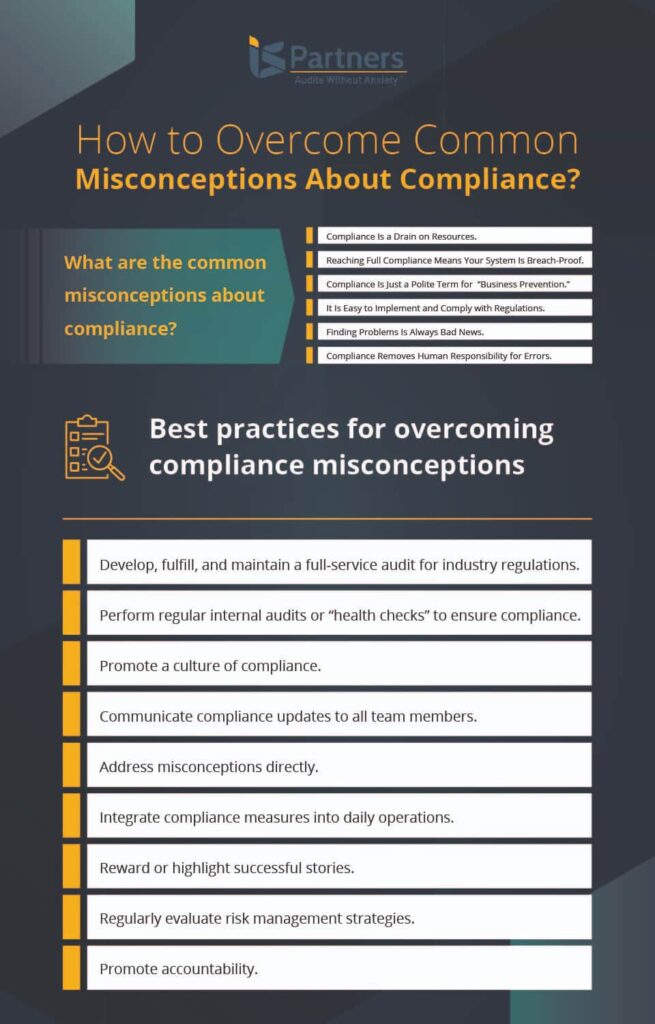Regardless of your company’s industry and background — which might involve finance, healthcare, energy, manufacturing, retail, and more. Certain legal requirements and regulations are in place to protect your company, making compliance essential.
Sometimes these legal requirements and regulations stem from federal mandates while you will come across others from local and regional entities. Regardless of the origin of any regulation requiring compulsory compliance, it generally benefits and protects your organization, stakeholders, and customers. This makes it critical to develop a strong compliance team and ensure everyone in your organization is on board.
In this article, we talk about the critical nature of compliance and how your organization can get the best out of it.
Key Takeaways
1. Security compliance refers to an organization’s commitment to following particular industry standards and requirements.
2. Cybersecurity compliance aims to assess security frameworks, identify vulnerabilities, and establish a working system to protect company data.
3. IS Partners, LLC is an auditing firm specializing in performing compliance evaluations and helping organizations follow suit.
What Is Regulatory Compliance in Cybersecurity?
Compliance with regulations refers to an organization’s adherence to established standards and requirements accepted by a particular industry. In context with cybersecurity compliance, this refers to following industry regulations that protect data and promote information security management systems.
Regulatory requirements include key aspects, such as the following:
- Data protection
- Privacy frameworks
- Security standards
- Reporting and auditing
- Incident response
- Employee training on security
The federal government and the major industry organizations establish compliance regulations. Compliance with regulations is a legal requirement and ensures security for all stakeholders.

Why is compliance important in information security?
The main significance of compliance with information security management systems is the protection they offer against threats to your assets. It also helps organizations create a systematic framework that will reduce risks for seamless operations.
Here are some key reasons why compliance is important in information security:
- Legal requirements and industry best practices. Compliance regulations and security controls are based on comprehensive evaluations of organizations and the government. Requirements help ensure that your business is protected from threats that have been previously reported.
- Protecting sensitive data. Information security frameworks are geared towards protecting critical and sensitive data that can cause public alarm when breached. Adhering to compliance standards helps prevent any data breach, unauthorized access, disclosure, or manipulation of this sensitive information.
- Preserving consumer trust. Organizations that comply with strict regulatory requirements show commitment to protecting consumer information, thereby fostering trust. A strong reputation for security can be a competitive advantage in the marketplace.
- Mitigating cyber risks. Compliance regulations also include systems for comprehensively evaluating vulnerable and risk-prone areas of the organization. This aspect can help companies build stronger security measures and better risk management.
- Incident response and recovery. For continuous improvement, requirements also include steps for incident response planning and readiness. This aspect helps ensure that companies are prepared to address issues as they occur and recover while minimizing any potential damages.
Compliance in information security is more than just following a set of rules and industry standards. It is a strategic and proactive approach to managing risks, protecting information, and maintaining the trust of all customers.
How to Best Apply Compliance Guidelines?
Compliance guidelines are, at best, generalized standards that are primarily loose-ended. They are often open to interpretation but fail to address problems particular to each organization.
Partner, Robert Godard, explains “strictly following guidelines may not lead to a successful security environment. Some organizations do not conform the regulatory framework to their environment; they essentially take the guidance as-is instead of assessing the frameworks’ relevance to their own operations.”
Organizations can go beyond the guidelines and enlighten employees on how human errors impact data security. These human errors are actions or inaction resulting from a lack of skill or wrong decisions.
For instance, in cases where guidelines try to protect the organization from phishing, they can further teach their employees how this relates to the nature of their job and give them practical examples of how cybercriminals can use the data they collect during social engineering campaigns. According to an IBM report, human errors account for about 95% of data security and compliance breaches that compliance guidelines may fail to address.
What Are Common Misconceptions About Compliance?
Many professionals who may or may not understand the importance of regulations tend to harbor frustration over the need to comply. You might have even had someone say to you, upon learning your regulatory responsibilities, that you are in the “business prevention unit.” All because they perceive this necessary function as the fastest way to bring productivity to a grinding halt.
This type of misconception can prove challenging and demoralizing for your compliance team. As you work toward maintaining strong morale among your team members who ensure compliance, it might help you to learn that you are not alone when you run up against misconceptions from frustrated colleagues, management, and executives in your organization.
Take a look at these common misconceptions about compliance to prevent misguided approaches:
- Compliance Is a Drain on Resources. Compliance departments actually assist their company in making quality, informed decisions by providing timely, relevant, and trustworthy information to top management. Plus, avoiding the bad press of a breach and demonstrating dedication to cybersecurity can lead to more business for the company in the long term.
- Reaching Full Compliance Means Your System Is Breach-Proof. Many IT security audit companies believe that their company’s security compliance program is fully protected and safe from breaches when in full compliance. Even with regular compliance audits and updates, no system is 100% secure. Staying ahead of modern cybercriminals is an essential tactic among savvy IT managers and compliance teams. Monitoring for changes in regulations, taking appropriate actions for their implementation and compliance, and keeping your staff, managers, and executives briefed on those changes are essential to success.
- Compliance Is Just a Polite Term for “Business Prevention.” While most of your colleagues and managers consider compliance a nuisance that inhibits productivity, it is just the opposite. Any time that loss of data or fallout from a third-party intrusion can be prevented via industry-tested — and industry-required — safeguards, everyone can do their job with confidence and efficiency. Your colleagues enjoy a great deal of freedom in their daily activities, whether they realize it or not, thanks to the hard work of your compliance department.
- It Is Easy to Implement and Comply with Regulations. Learning, understanding, and developing your organization’s regulatory compliance parameters takes a lot of work. Regulators want to verify that your compliance plan has substance and allows you to implement and track security practices. It takes work from everyone in your organization to reach a high degree of confidence in security, but compliance becomes easier as policies and procedures become ingrained.
- Finding Problems Is Always Bad News. Many managers and executives might feel that “no news is good news” and, conversely, that doom is imminent anytime you find a problem. Diligently compliance with regulations is designed to help detect a problem before it officially becomes bad news for your organization. The idea is that prevention is the strongest form of mitigation.
- Compliance Removes Human Responsibility for Errors. Compliance is an ongoing effort of shared responsibility never works on “auto-pilot” mode. Cyberattacks are becoming more frequent and aggressive, which means that one wrong move, like accidentally clicking on a link from an unauthorized source or writing their password down in an unsecured place, can lead to a breach. Security teams must be vigilant and aim for ongoing improvement. Awareness and training are important parts of compliance because they help employees at all levels recognize their role in keeping the organization secure daily.
Understanding the critical role of compliance and dispelling misconceptions allows team members to work on a common goal more efficiently. While compliance with regulations and standards does not protect your organization 100%, it creates security programs that mitigate damages and problems.
Allow our expert auditors from IS Partners, LLC to analyze your security compliance, assess your management needs, and help you establish the most appropriate security measures. Contact us now and learn more about your auditing needs today.
How to Overcome Common Misconceptions About Compliance?
Looking at the above compliance misconceptions, you might wonder how to overcome them to help your organization’s staff and managers help you work toward solutions. Understanding the importance of compliance measures is just the first step in a series of ongoing functions.
Below are a few best practices that you can use to overcome common compliance misconceptions:

- Develop, fulfill, and maintain a full-service internal audit function to check the status of regulations in the industry regularly.
- Perform regular internal audits, or “health checks” to ensure compliance.
- Promote a culture of compliance.
- Communicate compliance updates to all team members.
- Address misconceptions directly.
- Integrate compliance measures into daily operations.
- Reward or highlight successful stories.
- Regularly evaluate risk management strategies.
- Encourage senior management to lead in providing advisory services for a top-to-bottom breadth of accountability.
Security compliance management is a combination of proactive and multifaceted approaches. All members of an organization must clearly understand the goals and importance of compliance to facilitate better outcomes.
Perform these functions and contact a compliance firm specializing in staying abreast of the most updated industry regulations. Cybersecurity consultants at IS Partners, LLC can help you develop the most effective and efficient strategies to keep everyone in your organization on their toes.
Considerations Affecting the Effectiveness of Compliance in Security
Security compliance procedures vary depending on the target industries and business processes. Not all compliance requirements are one-size-fits-all. Similarly, some compliance regulations are more adaptive than others. Making them more versatile and the effects longer lasting.
This section explores key considerations, challenges, and strategies for fortifying security compliance measures, ensuring organizations are resilient and adaptive in the face of an ever-present and sophisticated array of cybersecurity threats.
Cyberthreats Are Always Evolving
Hackers, APTs, and entities like that develop new ideas and methodologies daily. Compliance with frameworks and standards will never account for that constant evolution. A compliance-only approach provides a blueprint for cybercriminals, as they can efficiently study the guidelines and find loopholes that can be exploited in the regulation.
Most data security compliance regulations are reactions to threats by cybercriminals. In many cases, regulations are put in place when cybercriminals start exploiting a flaw in a product, and organizations try to mitigate the resulting threat by providing an update to existing guidelines or coming up with new policies.
Breaches Can Go Unnoticed
Research carried out by Specop software showed that up to 83% of known compromised passwords would satisfy regulatory requirements. Though many industry-specific and location-specific data regulations exist, organizations are still far from invulnerable to cyber-attacks.
The number of high-profile data security breaches in the 21st involves organizations meeting regulatory compliance requirements to protect their data.
According to Chris Pogue, a co-author of the Nuix Black Report, “Data breaches take an average of 250-300 days to detect—if they’re detected at all—but most attackers tell us they can break in and steal the target data within 24 hours,”.
When organizations try to build their data security based on compliance, without ongoing monitoring and testing, attempted and successful attacks can go unnoticed and unaddressed.
Compliance Frameworks Are Always Behind the Curve
One of the biggest problems with compliance guidelines is how long it takes to update them. Cybercriminals are always on their toes, hacking and developing new ways to exploit organizations’ data security. However, it can take regulators months to identify, understand, and tackle loopholes in the guidelines.
Compliance isn’t enough because it relies on frameworks and certifications that follow what’s happening now. For example, PCI DSS version 3.2.1 was released in 2017 and ISO 27001 was published in 2013, yet those standards are still being used today. Compliance built according to a framework or certification requirements is only as valuable as it is up to date.
Here’s an example of how that plays out: One of the more prevalent types of attacks we see is ransomware. This type of attack works by encrypting data and altering it surreptitiously; before the organization knows it, all your data has been modified and rendered inaccessible.
One of the strongest preventative measures against ransomware is dynamic file integrity monitoring which enables a cybersecurity compliance program to constantly watch the data associated with files and detect when any change has been made. It notifies the organization when/if the file’s integrity has been somehow undermined.
Another example is when the NIST framework recommended that passwords be changed every 90 days. Then, with the release of NIST 800-53, we see that recommendation be reversed. This is because new research has shown that changing passwords frequently is an ineffective security measure and can sometimes have the opposite effect.
If an organization is adopting an outdated framework, the organization can’t be sure that current best practices are being implemented.
True Assurance Requires Testing
“Compliance isn’t enough because, at a certain point, after you have checked controls and settings, you have to test them in a practical way. That’s why we use pen tests and vulnerability assessments, to test and see if those controls are working together properly and actually can stop someone from penetrating your network or getting to your critical data,” explains T. Anthony Jones, Senior Partner at IS Partners, Certified Information Systems Auditor (CISA), Certified Information Systems Manager (CISM), Qualified Security Assessor (QSA), and Certified ISO/IEC 27001 Lead Auditor.
This audit testing technique is naturally more agile and up-to-date than a compliance framework.
What Security Measures Should be Adopted Beyond Compliance Standards?
Many cybercriminals target the weakest link in the data lifecycle. These organizational vulnerabilities depend on culture, work habits, and technology practices. The priority for organizations should be data security, while compliance should be a subset of the organization’s overall security strategy.
- Regular Security Testing and Scanning – “Above and beyond what compliance requires, we advise our clients to do pen tests twice a year and vulnerability testing quarterly. With these testing methods, we can identify vulnerabilities that any framework would have difficulty protecting the organization against,” says Anthony. The methods and tools used in penetration testing and vulnerability scans are usually some of the most up-to-date resources for current vulnerabilities. Testing and scanning supersede the compliance framework by leveraging a smart antivirus that updates its definitions and uses heuristics or behavior-based detection.
- Employee Awareness Campaigns – “The other thing that organizations should be doing is phishing campaigns. Typically, your employees are your weakest link. Most attacks these days start as an email with a link that an employee clicks. More than likely, that’s how hackers get in. If you haven’t trained employees to look for these things, to be aware of them, and report them, when they get a link sent to their computer or cell phone, you can do all the security stuff we’re talking about, but it won’t matter. It won’t make a difference. So, employee awareness training is crucial,” explains Anthony.
- Staying Informed and Up to Date – It’s important to remember that security doesn’t stop at certification. Your organization needs to be proactive and constantly working towards improvement. This means staying current on new vulnerabilities, developing threats, and ongoing education and awareness for their staff. This also includes practicing incident response and repeating training.
- Combining and Diversifying Efforts – “Compliance certification can give a false sense of security,” adds Anthony. “All of the reactive components of a security program can suffer under the guise that because a certain framework has been adopted or certification has been achieved, real threats are no longer a concern. That’s why the best security plan for your environment combines all these activities and efforts together.”
While adhering to established rules and standards is a foundational step, it is equally crucial to implement additional protective measures. Vigilance against potential online threats is imperative, and providing comprehensive training to all team members is essential to enhance our collective defense.
Compliance regulatory requirements are ever-evolving. This means that your security frameworks must constantly change and adapt to keep up with the potential cybersecurity threats.
Get the Best Solution to 100% Compliance from IS Partners
Compliance with regulatory standards and requirements may differ depending on a particular industry setup. As such, you need an adaptable solution that efficiently accommodates varying and growing needs.
IS Partners, LLC specializes in tailoring solutions for organizations seeking compliance with regulatory requirements. Our expert auditors are well-versed in evaluating company security standards from different industries.
Whether it may be for compliance management and certifications from local or international standards, such as GDPR, ISO, HIPAA, or PCI DSS, we can help you maintain excellent standing.
Allow our team of auditors to guide you in determining which compliance needs and help you establish the appropriate frameworks for cybersecurity assurance.







